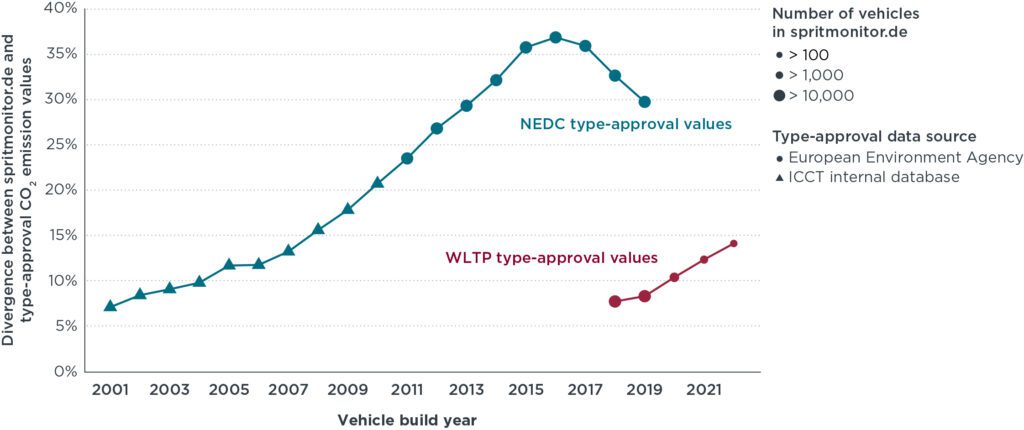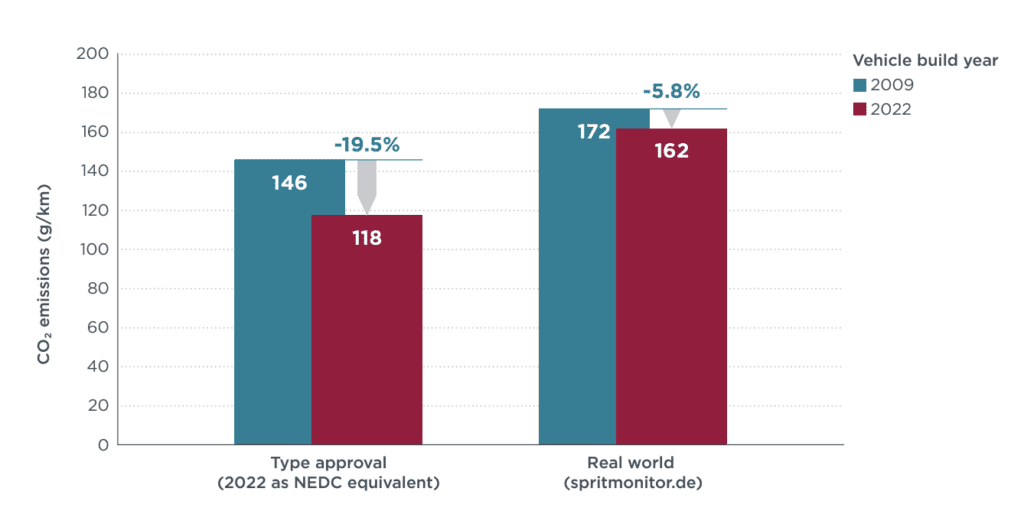White paper
On the way to ‘real-world’ CO2 values? The European passenger car market after 5 years of WLTP
This paper investigates how the gap, or divergence, between official and real-world data on CO2 emissions from passenger cars in the EU has developed since introducing a new type-approval test procedure, the Worldwide harmonized Light vehicles Test Procedure (WLTP). The results indicate that there is a growing divergence between real-world and WLTP CO2 emissions data for internal combustion engine cars and hybrid cars, as observed for New European Driving Cycle (NEDC) type-approved vehicles in the past.
Figure 1 shows that the official WLTP type-approval CO2 emission values are more representative of real-world values than the ones from the previous NEDC test procedure. Our analysis shows a divergence of 7.7% for WLTP in 2018 compared to 32.7% for NEDC. However, the gap between real-world and official CO2 emissions increased by over 80% in the 5 years since the introduction of the WLTP, reaching 14.1% in 2022.

Figure 1. Divergence between real-world and type-approval CO2 emission values for internal combustion engine and hybrid passenger cars registered in Germany. Data sources: European Environmental Agency (EEA) and spritmonitor.de
This growing gap diminishes the effectiveness of the European Union’s CO2 standards in reducing tailpipe CO2 emissions from cars and vans. This is because CO2 reduction goals are implemented by setting lower targets for official CO2 emissions. The growing gap between official and real-world emission values, however, leads to a lower reduction in real-world CO2 emissions than intended by the regulators.
Figure 2 compares the reduction in official versus real-world CO2 emissions between 2009 and 2022. While official CO2 emission values decreased by 19.5%,real-world emissions decreased by only 5.8% over the same period due to the growing gap.

Figure 2. Reduction of internal combustion engine and hybrid car type-approval and real-world CO2 emissions since the adoption of CO2 standards in the EU in 2009 and 2022. WLTP CO2 emissions in 2022 were converted to NEDC-equivalent values using a conversion factor of 1.21.
The analysis is based on official CO2 emission data reported by the European Environment Agency (EEA) combined with real-world fuel-consumption information from more than 160,000 combustion engine and conventional hybrid cars reported by consumers on the spritmonitor.de platform.
The European Commission has been tasked through the CO2 standards regulation with developing a mechanism or process that prevents this gap from growing. For this purpose, real-world fuel consumption data recorded by on-board fuel and energy consumption monitoring (OBFCM) devices should be used. However, while the availability of OBFCM data will allow the implementation of such a mechanism by 2027, regulators foresee this measure starting in 2030.
Based on the analysis, the authors offer the following recommendations to prevent the gap from growing and mitigate excess CO2 emissions caused by a growing gap, using reliable and transparent data:
- The European Commission could develop a mechanism that prevents further growth of the gap, and a proposal for such a mechanism is provided in this paper. The described mechanism intends to both mitigate the growing gap and compensate for the excess real-world CO2 emissions released prior to the introduction of a correction mechanism.
- The availability of OBFCM real-world consumption data would support applying the correction mechanism starting in 2027.
- Real-world fuel consumption estimates could be displayed on vehicle efficiency labels for consumers.
- Anonymized OBFCM data could be made publicly available.
- OBFCM could be made mandatory for electric vehicles to ensure the availability of real-world energy consumption data.
